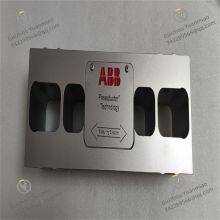Material
Other, Global universal model
Condition
Other, Global universal model
Task
Other, Global universal model
Mathematical Model
Other, Global universal model
Signal
Other, Global universal model
Customized
Non-Customized
Structure
Other, Global universal model
Operating Temperature
-40°C to +70°C
ABB PFTL101BE 2.0kN 3BSE004214R1Overview
The ABB PFTL101BE 2.0kN 3BSE004214R1 is a pillow-type weighing sensor specially designed for harsh industrial environments, belonging to ABB's Pressductor series. With advanced sensing technology and excellent manufacturing processes, it plays a key role in numerous industrial fields, especially in scenarios with extremely high requirements for tension control accuracy. This sensor is designed to accurately measure and stably control the tension of materials in production processes, providing strong support for ensuring product quality and production efficiency, and meeting the needs of modern industrial automated production for high-precision and high-reliability measurement equipment.
Functional FeaturesHigh-Precision Measurement
Adopting advanced sensing technology, it can accurately capture minute tension changes, ensuring precise measurement even at low tension levels. It provides accurate data for tension control in production processes, effectively guaranteeing the stability of product quality. Whether for fine paper, films, or industrial strips, its tension changes can be accurately sensed by this sensor.
High Reliability and Durability
Made of high-quality stainless steel, it has excellent protection capabilities with a protection level of IP68. This enables it to operate stably in harsh industrial environments such as high humidity, strong dust, and corrosive gases, demonstrating good wear resistance and corrosion resistance. It greatly reduces equipment failure risks and maintenance costs, ensuring long-term stable measurement performance.
Fast Response Characteristics
With an extremely short response time, it can quickly react to tension changes. This feature makes it particularly suitable for high-speed production lines, enabling timely adjustment of tension, avoiding product defects caused by tension fluctuations, improving production efficiency, and meeting the requirements of modern industrial high-speed production for rapid equipment response.
Easy Installation
With a compact design and reasonable structure, it is easy to integrate and install with various mechanical systems. Whether in the construction of new equipment or the transformation and upgrading of existing production lines, it can be easily integrated, reducing installation time and workload and improving the efficiency of system construction and transformation.

Technical Parameters
Rated Capacity: 2.0kN (2000N), clarifying its standard load-bearing capacity range, suitable for measurement scenarios with corresponding tension levels.
Output Signal: Can provide standard signals such as mV/V or 4-20mA, facilitating seamless docking with various measurement and control systems, and enabling convenient data collection, transmission, and processing.
Nonlinear Error: ±0.02%FS, ensuring the accuracy of measurement results and reducing production deviations caused by measurement errors.
Repeatability: ±0.01%FS, ensuring the consistency of results when measuring the same tension multiple times, and improving the reliability of measurement data.
Creep: ±0.02%FS/30 min, maintaining stable measurement accuracy under long-term loads and avoiding measurement drift over time.
Temperature Influence: ±0.005%FS/°C, less affected by environmental temperature changes, and capable of maintaining stable measurement performance over a large temperature range.
Operating Temperature Range: -40°C to +75°C, adaptable to a wide range of industrial environment temperatures, and capable of normal operation in both cold production workshops and high-temperature workplaces.
Working Principle
This sensor is based on ABB's unique Pressductor technology and works on the principle of the magnetoelastic effect. Its internal core components are composed of specially treated magnetic materials. When an external force (i.e., tension) is applied to the sensor, the magnetic permeability of the magnetic materials changes accordingly under mechanical stress. The sensor is internally equipped with primary and secondary windings. When an alternating current is passed through the primary winding, a magnetic field is generated. When no external force is applied, the primary and secondary windings are perpendicular to each other, and no magnetic field is generated around the secondary winding. Once the sensor is subjected to tension in the measurement direction, the magnetic field propagation path changes, causing a magnetic field to be generated around the secondary winding and inducing an alternating voltage. The control unit converts this alternating voltage into a direct voltage output proportional to the applied tension. By accurately measuring and analyzing the output voltage signal, the magnitude and direction of the measured tension can be precisely obtained, achieving precise monitoring and feedback of material tension.
Application FieldsPaper Industry
It plays a key role in the entire paper production process. It can be used in paper machines to real-time monitor the tension of paper during the forming process, ensuring uniform paper thickness and a smooth surface; in calenders to precisely control the tension during paper calendering to avoid paper wrinkling or breaking; and in coaters to ensure stable paper tension during coating, enabling uniform coating coverage and improving paper quality.
Textile Industry
Used for tension measurement and control in the fabric production process. In the spinning process, it ensures stable yarn tension to prevent uneven yarn thickness; in the weaving process, it ensures appropriate tension in the warp and weft directions of the fabric to avoid fabric deformation, defects, and other problems, improving the quality of textiles.
Metallurgical Industry
For strip production, it can accurately measure the tension of strips in processes such as rolling and stretching. Through stable tension control, it ensures consistent strip thickness and good surface quality, reduces the reject rate, and improves production efficiency.
Other Industrial Fields
In mechanical engineering, it can be used in material testing equipment to accurately measure the force on materials in tests such as tension and bending, providing accurate data for material performance analysis; in fields with extremely high precision requirements for components, such as aerospace and automotive industries, it is used for precise tension control to ensure dimensional accuracy and quality stability in component manufacturing processes.










































